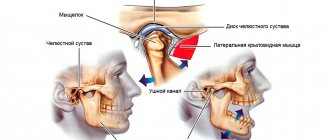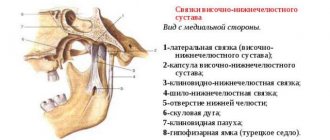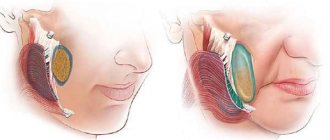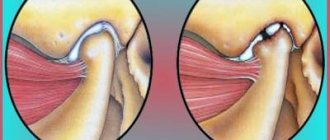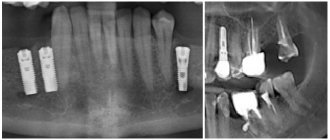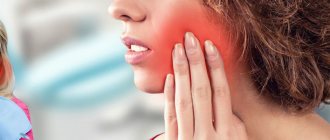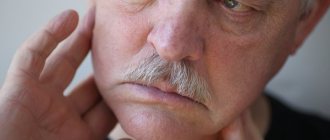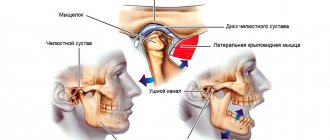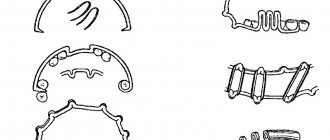Table: how to figure out who to contact
| What's troubling? | Which dentist should I contact? |
| Bleeding gums/Teeth sensitivity | Hygienist or periodontist |
| Missing teeth | Orthopedist |
| Have crooked teeth/bad bite | Orthodontist |
| Tooth hurts / The wall has broken off / There is caries | Therapist |
| The wisdom tooth is painfully erupting / Swelling has appeared on the side of the cheek | Surgeon |
All dentists conduct an examination, consultation, draw up a treatment plan and perform a thorough diagnosis of the entire oral cavity. In modern dentistry, an integrated approach to each clinical situation is valued, taking into account all the individual characteristics of the patient’s body.
Crunching jaw: how to treat and which doctor to contact
The first question that arises for people who are faced with crunching and discomfort in the jaw is what should be done, which doctor should they contact, should they do anything at all? It all depends on how long ago the jaw began to crunch, what caused this unpleasant phenomenon, whether the crunch is accompanied by other symptoms, and whether it limits the movement of the jaw. It is important that in no case should you self-medicate, which can aggravate the situation, and postpone a visit to the doctor.
Treatment of TMJ by our experienced gnathologists who:
- are able to carry out accurate diagnostics and apply their results in practice
- high-quality diagnostics using more than 50 parameters
- know how to treat so that the first result is noticeable within 7 days
- can prove their experience with successful results of more than 524 satisfied patients with TMJ problems
- quality treatment at prices in the residential area of Yasenevo
Dentist-therapist
The main field of activity of this doctor: treatment and prevention of caries and its complications. What manipulations does:
- treatment of caries;
- endodontics (work in root canals) for pulpitis, periodontitis;
- root canal retreatment;
- chipped fillings, tooth walls;
- carrying out treatment using a microscope (treatment of caries, work in canals);
- providing assistance for acute toothache.
The therapist also conducts a thorough examination and can refer the patient to related specialists if he notices any pathology.
Possible causes of pain
Most often, the joints of the jaw hurt because the muscle fibers are strained and anatomical changes occur in the joint unit. The situation is aggravated by psychological reasons, sleep disorders, and emotional stress. In addition, provoking factors include:
- Bruxism, that is, grinding of crowns;
- Osteopenic disorders of the body;
- Genetic bone pathologies;
- The jaw joint near the ear hurts when an infection develops, the patient has suffered a neck or head injury;
- Muscle pain, internal disorders, tension;
- Ankylosis, arthritis, excessive mobility;
- Lack of chewing organs, unprofessional orthodontic treatment;
- Active conversation load;
- Pain in the jaw joint and radiates to the ear in patients with the habit of biting nails or placing the smartphone close to the hearing organ;
- Problems of the central nervous system, scoliosis and osteochondrosis of the spine;
- Pathologies of the endocrine system;
In addition, dysfunction occurs with asynchronous movements of the joints on both sides.
Dental hygienist
A dental hygienist has a secondary professional medical education. A prerequisite for working as a hygienist is to successfully complete the course “Preventive Dentistry”. What does a dental hygienist do:
- professional oral hygiene;
- treatment of gums with the Vector device;
- whitening;
- provides training in proper oral hygiene;
- selection of personal hygiene products;
- deals with the prevention of gum disease in adults and children.
In short, the main area of work of a dental hygienist is the removal of dental plaque (tartar, plaque). It is important to see a hygienist every six months to maintain oral health.
Orthopedic dentist
Dental services include dental prosthetics. It is the orthopedic dentist who deals with all types of dental restoration using orthopedic structures. These include:
- crowns;
- bridges;
- veneers, lumineers;
- inlays, overlays;
- mouthguards, splints;
- temporary structures for long-term orthopedic treatment;
- removable and fixed dentures;
- prosthetics on implants.
Pediatric dentist
Treatment and extraction of teeth for patients under 18 years of age is carried out by a pediatric dentist. When working with young patients, the primary task is to find contact with the child and get him ready for treatment, because almost all children enter any medical office with fear. In addition, the children's doctor needs to tell the child's parents how to carry out home oral hygiene for the baby, what products to use, when the physiological change of teeth occurs, etc.
Maintaining dental health from a very early age is necessary for the normal formation of the dental system.
Gnathologist
Not everyone has heard of this doctor, and this is no accident. This profession is very rare.
This specialist deals with pathologies of the temporomandibular joint. If the patient is bothered by clicking in the joint, pain when opening the mouth, tooth wear, discomfort in the joint when chewing, then it is necessary to contact a gnathologist to eliminate the pathology.
- Pavel
October 7, 2022 at 08:17Thank you for your article, I learned a lot of new things. I had never had any problems with my teeth in my life, so there was no need to understand the areas of dentistry. And now the situation has changed, the first signs of dental ill health have appeared, we have to figure it out. First, I’ll go to my city free dentistry, then maybe I’ll go to a private clinic. Thank you for the clarification
Administrator
October 10, 2022 at 01:37 pm
Hello, Pavla! We are glad that you found the information useful. We invite you to see our specialists if you need dental care.
Bruxism: 3 steps to successful treatment
As a rule, the patient notices that he has clenched his jaw tightly only at the moment of awakening. Relatives may report a quiet grinding sound from clenched teeth, but sometimes attacks of bruxism are not heard.
“The symptom does not cause any particular inconvenience, and many do not see a doctor for years. Meanwhile, the teeth are gradually rubbing against each other,” comments orthopedic dentist Denis Vladimirovich Ovchinnikov.
What is bruxism? This is a spasm of the masticatory muscles. The problem is very common: chronic bruxism occurs in 5-10% of the adult population.
Night cramps are caused by nervous tension and aggravated by pathology of the dental system. That is, the main reason is stress. Overwork, chronic lack of sleep, and information overload lead to an increase in cases of bruxism among city residents, including young people.
The second group of reasons is associated with improper closure of teeth.
Neurological and osteopathic causes of teeth grinding are also less common. Bruxism can be caused by poor nutrition: lack of calcium or magnesium.
Consequences:
- The teeth are severely worn out, the bite decreases;
- Fillings and crowns chip and break;
- Teeth become sensitive and mobile;
- Facial aesthetics deteriorate: a fold appears near the lips, a sloping chin;
- Headaches and muscle pains (neck, shoulders, back), pain in the jaw joints, and insomnia occur.
Which doctor should I contact?
Contact your orthopedic dentist to find dental causes or catalysts for bruxism:
- Bite disorders
- Incorrectly installed crown or filling
- Missing 1 or more teeth
Most likely, you will need to visit a therapist (not a dental therapist, but a local doctor). He will identify the cause of the disease and refer you to a specialized specialist: a neurologist, osteopath or psychotherapist, or help you adjust your diet.
Using a facebow
and articulator before installing crowns reduces the risk of bruxism
The doctor in the photo -
orthopedic dentist Denis Vladimirovich Ovchinnikov
Completing T-scan diagnostics
On the monitor, tall bars indicate supercontact points.
Treatment of bruxism. Step 1 – Protecting Your Teeth
To prevent teeth from being worn down by high loads, it is recommended to wear a special protective mouthguard at night. They are made in dental laboratories from soft plastic or rubber, and strictly according to the shape of the patient’s jaw. This makes them comfortable and discreet to wear. There are self-adjusting bite trays made from water pads, this is also an effective method.
What does a mouth guard do:
- Does not allow teeth to wear out;
- Protects teeth from displacement;
- Reduces the load on the facial muscles;
- DOES NOT eliminate the cause of the disease, DOES NOT treat the consequences of tooth wear.
“Wearing a mouthguard relieves the symptoms of bruxism and the headaches it causes. But the mouthguard does not remove the cause and should be used in combination with other treatment methods ,” warns orthopedic dentist D.V. Ovchinnikov.
Step 2 - eliminating the cause
You will not be able to cope with bruxism on your own. A doctor's help is needed.
Treatment is prescribed depending on the cause. Most often, an integrated approach is used: a combination of psychotherapeutic, medicinal, and dental methods.
- Correcting the bite with braces or aligners.
- Dental prosthetics: in some cases, remaking a low-quality prosthesis eliminates the problem completely.
- Consultation with a psychotherapist or psychologist: to learn ways to unload the nervous system.
- Drug treatment: taking antidepressants, sedatives, B vitamins, ascorbic acid, calcium, magnesium. Sometimes anti-inflammatory drugs are required.
“Patients 30-40 years old come in with worn-out teeth and a reduced bite like a 60-year-old. They spend money on a facelift to avoid sagging cheeks, and bruxism aggravates the problem every year ,” says Denis Vladimirovich.
A quick and mandatory method of helping with bruxism is the elimination of supercontacts, that is, points of increased stress. There the teeth close first and begin to press on each other before the rest close. If a tooth has shifted, tilted towards its lost neighbor, or an uncomfortable filling or denture has been placed, a supercontact point appears.
The body unconsciously tries to get rid of supercontact, to erase this bump. But while this happens, other teeth and the jaw joint will suffer.
An orthopedic dentist can identify problem areas using special sensory equipment, if the clinic is equipped with one. With an ultra-sensitive sensor, it finds supercontacts smaller than the thickness of a human hair. So the doctor determines not only their location, but also the degree of load on each.
Supercontacts are removed by grinding. After this, the patient immediately feels improvement.
Step 3 - correcting the consequences
After eliminating the cause of bruxism, you can move on to restoring your teeth. With low abrasion, procedures to strengthen the enamel are sufficient. In more advanced cases, restoration with photopolymer or dental prosthetics is required.
If you delay the treatment of bruxism for several years, the teeth will be severely worn, the bite will decrease, and total dental prosthetics will be required.
High-quality dentures can not only protect worn teeth from destruction, but also compensate for lost bite height. The shape of your face will become more aesthetic and toned.
“I emphasize. If you manage to catch a patient with bruxism in the early stages, grinding the teeth, remineralization and a course of mild sedative will be enough. If the situation gets worse, it will require expensive complete prosthetics of all teeth, and possibly treatment of problems with the jaw joint and cervical spine.” Ovchinnikov D.V.
The only way to prevent bruxism is to regularly monitor the health of your teeth and nervous system. Get more rest and consult a doctor in a timely manner for preventive examinations and treatment, including orthopedic.
Orthopedic dentist Denis Vladimirovich Ovchinnikov has been dealing with the problems of bruxism, tooth abrasion and occlusion disorders since 1995. The doctor sees patients at the CosmoStom branch on Volochaevskaya street 19/1.
